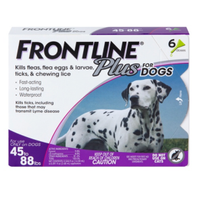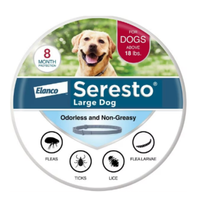Flea allergy dermatitis in dogs
A vet reveals everything you need to know about flea allergy dermatitis in dogs, from the signs to look out for to how to treat it.

Flea allergy dermatitis in dogs (FAD) is the most common dermatological condition our pups face and it can make their lives miserable if left untreated.
Caused by an allergy to flea saliva, one bite from a pesky parasite is all it takes to trigger uncomfortable symptoms such as itching and scratching. Thankfully, if caught early, it's an easy condition to treat and it can be prevented by regularly applying one of the best flea treatment for dogs.
Because it's one of the most common allergies in dogs, it's an issue that most vets deal with on a regular basis and so your fur friend's vet is the best person to speak with if you think your pup might be suffering from FAD.
However, to get you started with everything you need to know, we consulted Dr. Hannah Godfrey. Below, she explains in more detail what flea allergy dermatitis is, the signs to be on the lookout for, and the best way to treat it.
What is flea allergy dermatitis in dogs?
Flea allergy dermatitis is one of the leading causes of allergic reactions in dogs and like all allergies, it's caused by the immune system overreacting to a particular substance that's typically harmless — in this case, that substance is flea saliva.
"Flea allergy dermatitis is a health condition affecting some dogs who are allergic to flea saliva," Dr. Godfrey confirms. "When a flea bites, it causes an excessive reaction including lots of scratching, self-trauma, and hair loss, as well as raw sores on the skin which can become infected."
Believe it or not, a dog with FAD does not have to be infested with fleas to suffer — a single bite from a flea is enough to cause days of discomfort.
PetsRadar Newsletter
Get the best advice, tips and top tech for your beloved Pets
Signs of a flea allergy in dogs

Is your dog itching, scratching and biting all the time? They could have a flea allergy.
"Dogs with a flea allergy may scratch excessively, even when relatively few or no fleas are visible," explains Dr. Godfrey. "They often have patches of thin or broken fur where they have been scratching, and sometimes the skin is sore, oozing, or infected.
The common areas of skin that are affected are the skin along a dog’s back, from the shoulders to the base of the tail. However, other areas can be affected."
Remember, your dog doesn't have to be infested with fleas to have this reaction. One flea bite could cause them to chew, bite, itch, or scratch — which are all common signs of dog allergies.
If you see your pup engaging in any of these behaviors, especially if they're coupled with hair loss, it's important to get them checked over by a vet.
Our top pick when it comes to the best topical flea treatment for dogs, Frontline is easy to use, safe for dogs of almost all sizes, effective at killing both fleas and ticks at all stages of life, and waterproof (after 24 hours).
How is flea allergy dermatitis diagnosed?
If your dog is itching, scratching, losing fur, or just generally looking uncomfortable, it's important to get a proper diagnosis. That's because when it comes to how to help a dog with allergies, you first need to be sure you know exactly what allergy you're dealing with as many have overlapping symptoms.
"Flea allergy dermatitis may be diagnosed in dogs who are intensely itchy with a skin rash and visible fleas or flea dirt. There doesn’t have to be a large number of fleas for the diagnosis to be FAD – just one flea bite can trigger the allergic reaction," explains Dr. Godfrey.
"If the vet is unsure of the cause of the symptoms, they may take samples of the hair and skin cells to check for parasites and other causes under the microscope. They may also do blood tests and skin biopsies to confirm the allergy."
How do you treat flea allergy dermatitis in dogs?
The number one priority when it comes to dealing with FAD is to kill any fleas currently on your pup and prevent them from returning.
If they have an infestation you can pair an oral flea tablet with a topical flea treatment for fast-acting relief and then move to ongoing flea prevention, either by way of a topical or one of the best flea collars for dogs.
"Flea allergy dermatitis can often be managed with strict regular use of flea control products," confirms Dr. Godfrey. "This means treating all of the pets in the household as well as treating the home to remove any fleas from the environment.
To get the symptoms under control, the vet might need to prescribe anti-inflammatory medication, antibiotics, or anti-allergy medication." We recommend discussing your pup's situation with your vet who will be able to advise you on the best course of action.
The Seresto Flea and Tick Collar for Dogs is one of the most popular collars around — and for good reason. Not only is it fast-acting, it’s waterproof, protects against most pests and lasts up to eight months, making it an affordable flea-prevention option.
How long does it take for flea allergy dermatitis to go away?
Coping with allergic pets isn't easy, so if your pup is currently struggling with FAD, you may be wondering how long it will take before they start to feel better.
"Flea allergic dermatitis usually responds quickly to anti-inflammatory treatment, with symptoms improving within 24 hours," says Dr. Godfrey. "However, the condition won’t resolve completely and will soon deteriorate again if effective flea treatment isn’t also given."
Strict flea control is essential for managing this condition, so even if you don't see any pesky parasites on your pup it's important to continue rigorous flea treatment all year round.
How to prevent flea allergies in dogs
"Unfortunately, you can’t stop your dog from developing an allergy, no matter what you do," explains Dr. Godfrey. "However, with regular effective flea preventatives, you can make sure that any symptoms are always under control." Here are the safest flea treatments for dogs.
You might also want to read about skin conditions in dogs and what to do if your flea treatment is not working.

Dr Hannah Godfrey studied Veterinary Medicine at the Royal Veterinary College London. After graduating in 2011, Dr Godfrey went on to become a veterinary surgeon, conducting surgery consultations on a range of animals at a small independent practice in Cardiff, South Wales, UK. Dr Godfrey has a strong interest in soft tissue surgery. When she’s not helping animals back on their feet, Dr Godfrey writes a number of veterinary and animal-focused articles.

Kathryn is a freelance writer who has been a member of the PetsRadar family since it launched in 2020. Highly experienced in her field, she's driven by a desire to provide pet parents with accurate, timely, and informative content that enables them to provide their fur friends with everything they need to thrive. Kathryn works closely with vets and trainers to ensure all articles offer the most up-to-date information across a range of pet-related fields, from insights into health and behavior issues to tips on products and training. When she’s not busy crafting the perfect sentence for her features, buying guides and news pieces, she can be found hanging out with her family (which includes one super sassy cat), drinking copious amounts of Jasmine tea and reading all the books.


